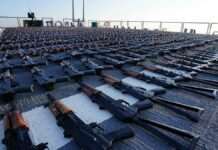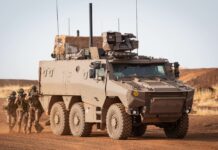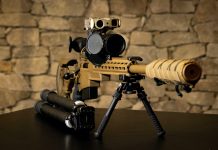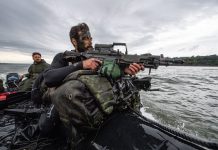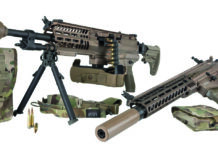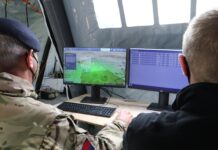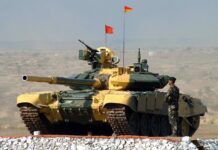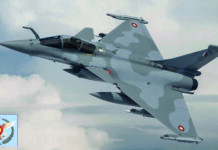
On Target – Advances in Small Arms Sights
David Saw
At first sight, the small arms sector is one where mature technologies hold sway and technological innovation is rare. Recently, however, there has been much innovation in the sector.
If you were to look at the military small arms sector in a rather superficial manner, you might conclude that real progress has been something of a rarity. For example, the standard NATO 7.62×51 mm round was standardised in 1954, with the US standardising the 5.56×45 mm round in 1963, while the NATO standard 5.56×45 mm SS109 round developed by FN Herstal was standardised in October 1980 – some 41 years ago. As such, there is not much evidence of visible change in the context of small arms ammunition.
Regarding small arms themselves, the evidence suggests very little change having taken place. The M16 rifle is arguably the dominant western assault rifle. It was first ordered in 1963 for the US Army, with production starting in 1964, and first deliveries in 1965. The M16 was developed from the AR-15, which had first seen combat in South Vietnam in 1961, so it would therefore seem fair to say that the dominant western assault rifle is a 60-year-old weapon. On the other hand, it could be pointed out that the current version of the M16 family used by the US military is comparatively less aged, as the M4 carbine was only selected in 1994.
Modifications Only
All of this would seem to indicate that the small arms sector is one where mature technologies hold sway and technological innovation is rare. There was a point where you could make an argument that all of this was true, though fortunately this argument only covers part of the story. In fact, there has been much innovation in the small arms sector, as the M4 has had nearly 100 modifications since it entered service, resulting in increased performance and a vastly reduced failure rate. Ammunition performance has also improved markedly. The latest rounds fit the standardised calibre dimensions, but offer increased range and penetrative power.
The primary contributing factor in advances in the small arms sector has been 20 years of war in Afghanistan since the commencement of Operation Enduring Freedom in 2001. Afghanistan, followed by Iraq, and then the expansion of the fight against terrorism to a global conflict, has created an environment where evidence from combat operations leads to new requirements and the money is available to turn those requirements into reality. In this environment, there is innovation, not just in how systems are being built by taking advantage of improvements in materials, optical, electro-optical and electronics technology, but also in how we look to meet operational requirements.
Fundamentals
To obtain an understanding of where we are now in terms of small arms sights and where we could go in the future, it is necessary to look at the evolution of small arms and the requirements that drive that evolution, and in turn the combat experience that drives the generation of requirements. The starting point for this analysis comes with the realisation that the bolt-action rifle and its full power round were not the optimum small arms solution for the infantry. Instead, the evidence pointed to the intermediate round, such as the German 7.92×33 mm Kurz and the Soviet 7.62×39 mm M43 rounds, as the optimum solution. In turn, these rounds prompted the arrival of the modern assault rifle.
In terms of sights, quality optics were expensive and therefore an optical sight was generally only issued to a sniper and attached to a selected highly accurate rifle. One of the first attempts at developing a night sight capability came from Germany, in the Zielgerät 1229 VAMPIR. The system entered service in limited numbers in 1944, issued to snipers and later integrated with the MG34 and MG42 machine guns. The sight was then integrated with the Sturmgewehr 44, arguably the first modern assault rifle, and used in combat from February 1945 onwards. The system consisted of an infrared light, an optical sight and a very heavy 15 kg battery pack carried by the operator. VAMPIR worked, but it was very cumbersome, and true night sights would only start to be a real possibility many years later.
Other Efforts
The British Army looked to introduce a new rifle to replace its standard bolt-action rifle and submachine gun, which resulted in the EM2 rifle in the intermediate 7×43 mm calibre. What was significant about the EM2 was that it had an integrated optical sight. The EM2 was an excellent weapon, a true assault rifle, although expensive, but some senior officers criticised it because its cartridge was not powerful enough for long-range accurate target engagement. Such engagements were a rarity rather than the norm, and across the vast majority of engagements a properly set up rifle with an optic would to be far more accurate than a conventional rifle.
As is commonly known, US Army pressure resulted in NATO adopting the 7.62×51 mm round as standard in 1954, and consequently, Britain dropped the EM2 and adopted the FN FAL in 7.62×51 mm. They did not fit the FAL with an optic, and Canada also adopted the FAL, though initially had an optic on the weapon, but this was subsequently discarded. NATO therefore had battle rifles with an over-powered cartridge that allowed for long-range engagements, but the vast majority of infantry have to make do with iron sights, which reduces the successful outcomes in such engagements.
Into the Night
It was the 1960s and the Vietnam War that saw the integration of a relatively effective night-fighting capability with small arms. By 1967, the US Army had started to field the AN/PVS-2 STARLIGHT scope, an image intensification system, which was a first generation device offering adequate performance. By the end of the 1970s, GEN II devices such as AN/PVS-4 were available, with these remaining in service post-2000. The arrival of GEN III tubes offered higher reliability and improved performance leading to such systems as the AN/PVS-17 Miniature Night Sight (MNS). Further development led to GEN III OMNI V–VII tubes and the resultant performance improvements.
In terms of night-fighting capabilities from the 1960s onwards, there have been important progress in technology and this has translated into major performance gains in night sights. Earlier generation systems were unreliable and tiring to use, unlike the current generation of systems. Perhaps the most important change in terms of night vision has been that of affordability. It was not that long ago that night vision devices, such as goggles and sights, were so expensive as to preclude widespread issue. This is no longer the case and, as a result, western armed forces have gained significant operational advantages due to enhanced night-fighting capabilities.
Night vision technologies are more readily available than before, both in terms of military grade and commercial grade systems. Inevitably, this has seen the proliferation of such capabilities and predictably, that has started to erode some of the night-fighting advantages enjoyed by NATO and allied forces. On the other hand, as long as the pace of technological innovation continues, then the night-fighting advantage will still be a critical factor in combat.
Optical Path
History repeated itself in the 1970s when Austria took into service the Steyr AUG (Armee Universal Gewehr) with its integrated Swarowski 1.5x optical sight. Elsewhere in the mid-1970s, the British introduced the L2A2 Sight Unit Infantry Trilux (SUIT); this was a 4x optical sight designed for daytime or low light conditions, and was adopted by the UK, Australia and New Zealand. In British service, it was used on the SLR (the British version of the FN FAL) and the GPMG (the British version of the FN MAG), but it was not widely deployed.
Things changed for the British when they adopted a new assault rifle in the mid-1980s in the form of the L85 in 5.56×45 mm calibre that came equipped with the L9A1 Sight Unit Small Arms Trilux (SUSAT), a 4x optic. Ironically, while the original L85 was a pretty horrendous weapon, the SUSAT was a fairly good optic. More than 30 years after they sought to provide their assault rifles with an optic, the British finally achieved that goal with the SUSAT.
The Canadian Armed Forces decided to replace their version of the FN FAL battle rifle, the C1 and the C1A1, in the mid-1980s with a 5.56×45 mm rifle that would be based on the Colt 715 and modified to meet Canadian needs. This resulted in the C7 assault rifle and later the C8 carbine. Like the British, the Canadians wanted to provide their new rifle with an optic and they selected the ELCAN SPECTER OS, a 3.4x optic that they classified as the C79. The C79 was attached to the weapon via a Weaver rail, but this was subsequently replaced by a MIL-STD-1913 Picatinny rail.
Special Operations
US Special Forces have been the catalyst for much of the development of optics, night sights and rails. Evidence of what can be achieved can be seen with the United States Special Operations Command (USSOCOM) Special Operations Peculiar Modification (SOPMOD). SOPMOD was an evolving series of kit designed to add sight, both day and night, and a host of other capabilities that could be integrated with the M4 carbine and the FN SCAR. As the SOPMOD programme evolved, other Special Forces’ weapons, including different rifles, light and medium machine guns and crew-served weapons were included. Operators select the appropriate options for their mission from the range of systems in the SOPMOD package.
The Block 1 SOPMOD package used the Knight Armament Company (KAC) Rail Interface System (RIS).Also included were the Trijicon Advanced Combat Optical Gunsight (ACOG), the Aimpoint CompM2 mount for the AN/PVS-14 monocular night vision device, Insight Technology AN/PEQ-2 infrared target pointer, illuminator, aiming laser and the Visible Light Illuminator (VLI) and the Trijicon reflex sight. Other options included the Insight Technology AN/PEQ-5 visible laser sight and the AN/PVS-17A MNS.
Improvements to Block 1 included a new RIS, with Insight Technology supplying the SU-233/PVS and SU-238/PVS gun lights. Also included were the EOTECH SU-231/PVS holographic weapon sights, SU-237/PVS ACOG and the AN/PVS-17A product improvement kit. The Block 2 package had the SU-232/PAS CNVD-T thermal sight, SU-231/PEQ holographic weapon sight, XPS-3 weapon sight, G33 magnifier, SU-230/PVS ELCAN SPECTER DR 1-4x optic and the L3Harris AN/PVS-24 clip-on night vision device. Further SOPMOD enhancements were integrated as requirements and systems evolved.
The SOPMOD effort commenced in the mid-1990s and it helped to drive the technology of sights forward and created the environment where conventional forces saw the utility of many of these sights and associated systems and took them into service. Finally, it seemed that the age of small being equipped with nothing more than iron sights was coming to an end in the more sophisticated conventional forces around the world. All of a sudden, Picatinny rails were sprouting all over assault rifles and there seemed to be no end to what soldiers were prepared to attach; optics, magnifiers, night sights, laser target pointers and tactical lights being the most common add-ons.
Urgen Requirements
Once Western forces became embroiled in ground combat operations in Afghanistan and Iraq, the demand for improved sights grew rapidly. For the British Army, combat operations in Afghanistan saw the issue of an Urgent Operational Requirement (UOR) covering the acquisition of the Trijicon ACOG to replace the SUSAT. Later, a more conventional procurement effort saw the acquisition of the ELCAN SPECTER OS, the Shield Close Quarter Battlesight (CQB) and Qioptiq thermal and night sights.
The US Marine Corps had earlier adopted the Trijicon ACOG in 2004 as the Rifle Combat Optic (RCO), and more recently, the US Marine Corps looked for an RCO successor system in the Squad Common Optic (SCO) programme. In January this year, they started fielding the SCO system having selected the Trijicon Variable Combat Optic Gunsight (VCOG), a 1-8×28 optic, to fulfil this requirement.
Another user who solved its evolving optic requirements by turning to its existing supplier was Denmark. In the mid-1990s, the Danish Army selected the Colt Canada C7A1 as its new rifle (GEVÆR M/95) and then took the C8A1 carbine into service as the KARABIN M/96. In parallel, they adopted the ELCAN C79 as their optic. In 2010, Denmark ordered a new variant of the Colt Canada rifle with an integrated upper receiver, with the weapon classified as the GEVÆR M/10, which became the primary service rifle. Denmark has now taken delivery of the ELCAN SPECTER DR 1-4x optic for its rifles and M60E6 machine guns, with their M2HB heavy machine guns equipped with the 1.5-6x version of the SPECTER DR.
Future Prospects
Lessons from Afghanistan and other combat operations have led to a rethink on a number of issues regarding small arms. Previously, the assumption was that most engagements would take place at distances up to 300 metres, but that has since changed and we are now looking at distances up to 600 metres and perhaps beyond. This has created a need for higher performance ammunition and, of course, for more effective sights.
Another issue was ammunition expenditure, which was far higher than anticipated, but the effects did not reflect the amount of ammunition expended. Obtaining more effects per round expended was another argument for improved sights and for improved fire control devices. The infantry soldier was already overburdened with too much weight, so if that could be reduced by maximising the utility of the ammunition carried, it would make a positive contribution to reducing the overall weight burden. In a related move, ammunition weight could be further reduced, for example, by the use of plastic cases.
Later in the Afghanistan conflict, the capabilities of the Taliban started to improve; for example, some Taliban groups began wearing body armour. The solution to these hardened targets was higher performance ammunition and, of course, better sights. Night combat remained an advantage for western forces, but again the Taliban started to acquire some night capabilities, meaning the solution was to improve the dependability and performance of western night sights and other night vision equipment.
As we know, there are currently very few limits on what can be attached to small arms in terms of sights and other accessories. To that end, we must add suppressors that are applied to small arms to reduce signature, which can be regarded as a positive, but on the downside, this adds more weight and size to the weapon. It is advisable not to add too much weight to the weapon and avoid any impact on its fit and form. An obvious solution is to reduce the weight of each of the items that can be added to the weapon, plus the requirement to reduce the weight of the batteries needed to power these items. Or we can look to have an integrated fire control system that includes all of the systems needed in terms of sights and related equipment in a single system.
The integrated fire control system appears to be the path to the future for small arms. A trend confirmed by the US Army Next Generation Squad Weapons (NGSW) programme to replace in-service US Army small arms, with its NGSW-FC fire control system element for which L3Harris and Vortex Optics are competing. ELCAN has developed their own fire control solution in the form of the SPECTER Digital Fire Control Sight (DFCS) and the system is already being evaluated by a number of NATO armies on different small arms platforms.
Futuristic Developments
Another option in the integrated fire control system area comes from Elbit Systems with their Assault Rifle Combat Application System (ARCAS), which is described as “a built-in computerised Artificial Intelligence (AI) powered system that interfaces with the rifle’s Electro-Optical (EO) sight, with a helmet mounted eyepiece and with the rifle’s assemblies, providing soldiers with real-time intuitive actionable combat information.” The ARCAS computer is integrated with the forward grip of the rifle, and receives and integrates data from the user’s EO sight, tactical information from C2 systems, data from other ARCAS users and information on the status of the user’s weapon. The user can view this data as an overlay on the EO sight picture or via an eyepiece mounted on the helmet. ARCAS can include thermal or low light sights, or interface with existing EO sights. The system has built-in growth potential and can also run third-party applications according to Elbit.
Where ARCAS is interesting is that it offers the opportunity to increase the situational awareness of the user and maximise the weapon’s potential. Beyond that, it offers another way to integrate the infantry soldier into a digitised operational environment.
Clearly, we are entering a future where just integrating an optic with the standard assault rifle is no longer enough. If integrated fire control systems can deliver the ability to acquire and accurately engage targets at the desired battle ranges in both day and night conditions, then this is the way forward. However, these integrated fire control solutions must not impose a significant weight burden and must be fully reliable in terms of fit, form and function.




